Almost 3,000 different animals are native to the United States, and there are several more introduced species on top of that. You don’t have to leave the country to see some incredible wildlife – much of it is roaming close to your home. Check out this list of 12 of the coolest animals in the United States, and where to see them in the wild!

1. Peninsular Bighorn Sheep (Ovis canadensis nelsoni)

These sheep have spectacular vision – they can see up to a mile away!
©Jilll Richardson/Shutterstock.com
The Peninsular bighorn sheep is unique subspecies of bighorn sheep (Ovis canadensis) that lives in North America. This endangered bovine species became native to the United States after its ancestors migrated across the Bering land bridge over 750,000 years ago. Now, this subspecies of bighorn inhabits low-elevation desert canyons, slopes, and washes in a concentrated region in southern California. The sheep require dry, rocky terrain with elevations up to 4,000 feet.
You can spot them in the San Jacinto and Santa Rosa Mountains, but be respectful. There are less than 1,000 known Peninsular bighorns left in the United States.
Cool Fact: Male bighorns have horns that weigh up to 30 pounds, and they use them to establish dominance by ramming their heads together at speeds of up to 40mph!
2. Tarantula Hawk (Pepsis albocincta)
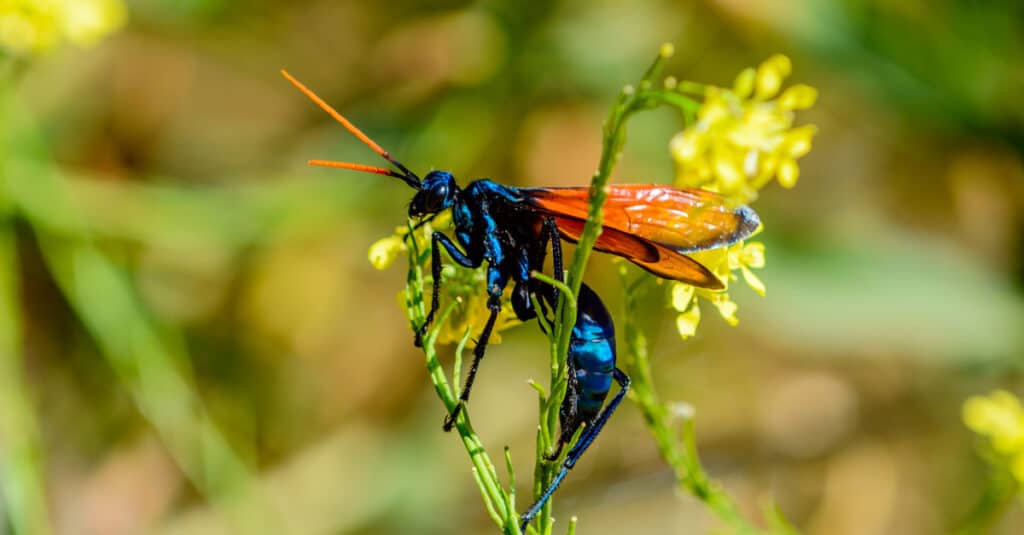
Tarantula hawks are one of the largest wasps in the world and grow up to 3 inches in length.
©Robert Briggs/Shutterstock.com
Meet the tarantula hawk, native to the southwest deserts of the United States, including New Mexico, California, and Arizona. Contrary to the name, this cool critter is not a spider or a bird, but a species of spider wasp. Instead, its name comes from its unique mothering habits, which include hunting tarantulas for use as food for its larva. In a gruesome process, a mother tarantula hawk paralyzes its prey and drags it back to her nest, where she will lay her egg in its abdomen. She then covers the burrow to prevent the spider from escaping. The larva hatches and feeds on the living spider, getting all of the nutrients it needs to develop into an adult wasp.
Cool Fact: Tarantula hawks are quite docile, but they will sting when provoked. A sting from one of these wasps is excruciating – the Schidmt sting pain index, a pain scale developed by former entomologist Justin O Schmidt, rates it as one of the three most painful stings in the world. You can check out the rest of the index on the United Kingdom’s Natural History Museum website.
3. Elegant Trogon (Trogon elegans)
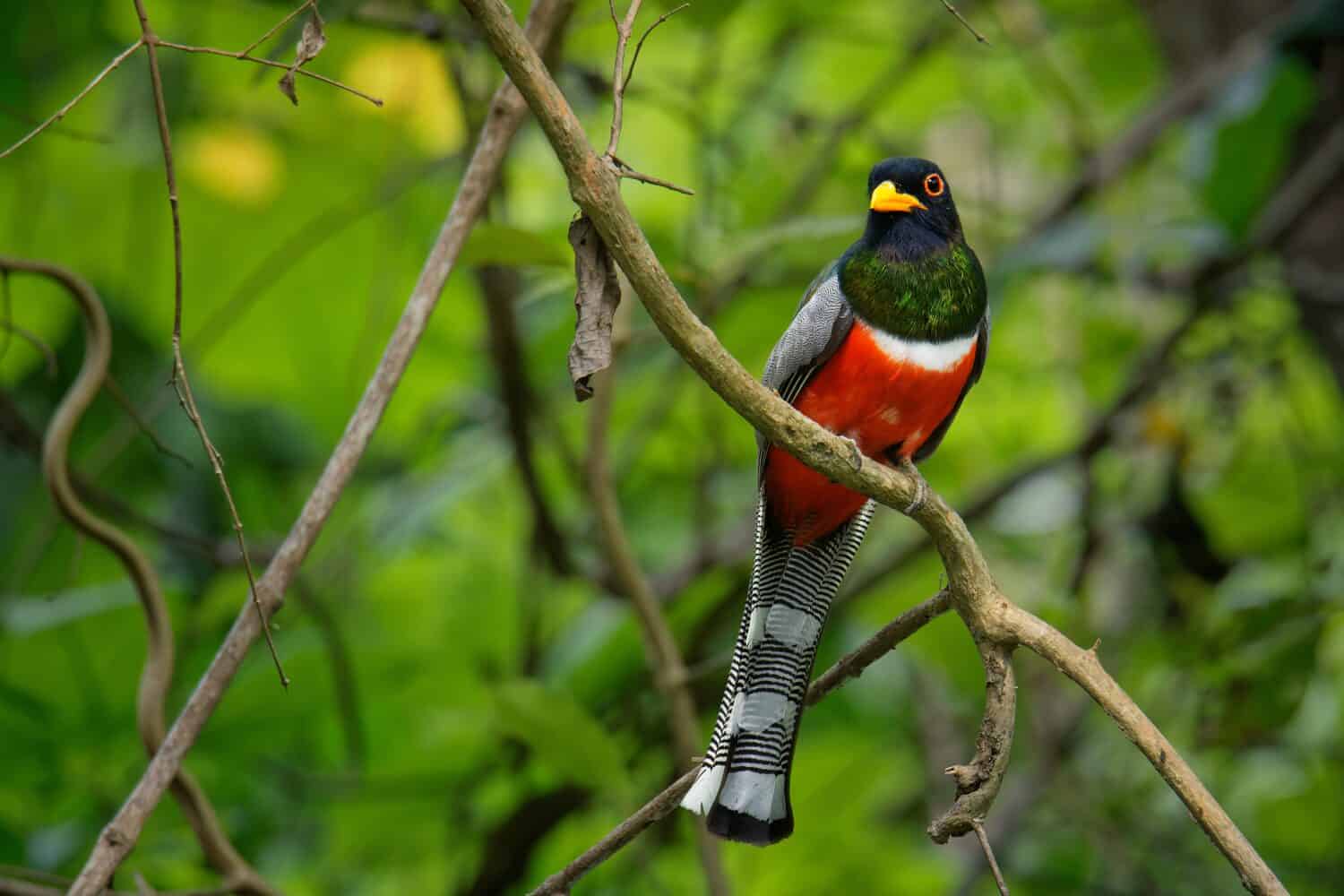
This beautiful southwestern bird is endangered in New Mexico.
©Martin Pelanek/Shutterstock.com
The elegant trogon is a rare species of bird in the United States and lives only in the southeasternmost part of Arizona and, rarely, New Mexico. Regardless, this exotic-looking bird draws birdwatchers from far and wide for its rarity and brightly colored metallic plumage. Five different subspecies exist under the label Trogon elegans, and the elegant trogon is only one of many distinct varieties of trogon. Outside of the United States, this fascinating bird is native to South America, where it resides in dense woodlands.
Cool Fact: The elegant trogon is a secondary nester, which means it makes its home in the old nests of other animals, such as acorn woodpeckers. The name ‘trogon’ translates to ‘gnawer’ in Greek, and describes the way it uses its hooked bill to hunt and eat insects.
4. Grasshopper Mouse (Onychomys)

In times of hunger,
grasshopper
mice will kill and eat each other to survive.
©Liz Weber/Shutterstock.com
The grasshopper mouse has three main subspecies, whose names are the northern grasshopper mouse (Onychomys leucogaster), southern grasshopper mouse (Onychomys torridus), and Mearn’s grasshopper mouse (Onychomys arenicola). They are nocturnal and aggressive mice, and are endemic to the United States, particularly in the western part of the country. All of these mice live in arid desert regions and grasslands, and they are carnivorous, feasting dominantly on venomous arthropods, including scorpions. This diet has earned them the name “scorpion mice”, and they are immune to the venom of their prey. Interestingly, the venom a grasshopper mouse consumes or is attacked with remains in its system. This offers a distinct defensive advantage against predators, who risk illness or death from the consumption of this sturdy little rodent.
Cool Fact: Grasshopper mice howl like wolves to scare off predators, communicate, and directly before making a kill.
5. Ghost-Faced Bat (Mormoops megalophylla)
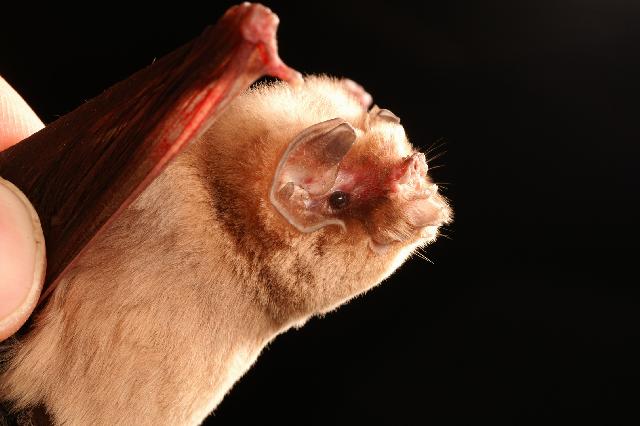
Perhaps the most fascinating thing about the ghost-faced bat is how little we know about it. Native to the southwest desert regions of the United States (Texas, New Mexico, Arizona), researchers have discovered little about its diet or lifespan. We also know very little about its reproductive habits. However, the strange appearance and great mystery of this flying mammal give it a spot on this list. Of the little we know, it is clear that this desert bat is an incredibly cool rarity. You’re not likely to spot this bat out and about, but a sighting is not impossible. These bats roost in caves, abandoned mines, and old buildings.
Cool Fact: The ghost-faced bat gets its name from the shape of its face, which appears smashed-in.
6. Brahminy Blind Snake (Indotyphlops braminus)

Tiny and adorable, Brahminy blind snakes are often mistaken for baby snakes of other species.
©Radiant Reptilia/Shutterstock.com
The Brahminy blind snake is a nonvenomous snake that inhabits the United States. While it isn’t native to the country, it has made a home in Florida, Connecticut, California, Georgia, Louisiana, Massachusetts, Hawaii, Arizona, and Texas. The snake is pretty common, but spotting it is hard. It is a burrowing snake and spends its whole life underground. This blind snake only grows to lengths of 6 inches maximum, making it one of the smallest snakes in the world! True to its name, the blind snake cannot see, but it can sense light.
Cool Fact: There are no male Brahminy blind snakes – the species is parthenogenetic and the offspring of parents snakes are genetically identical to their mothers.
7. Humpback Whale (Megaptera novaeangliae)
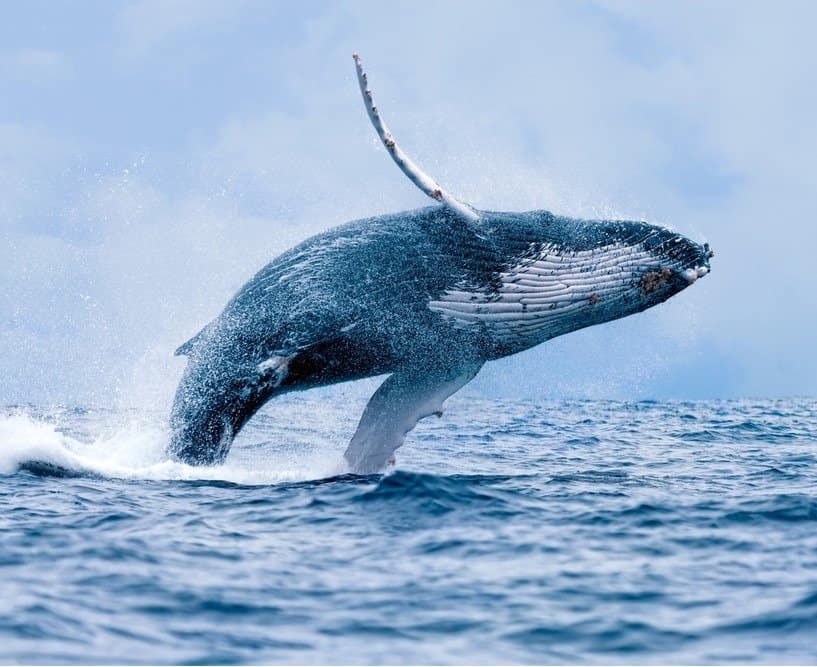
The scientific name of the humpback whale,
Megaptera novaeangliae, means ‘big wing of New England’.
©Paul S. Wolf/Shutterstock.com
The humpback whale is a species of baleen whale that lives in every ocean in the world, but you can see these amazing creatures in several places off the coast of the United States. Whale-watching tour boats take tourists and locals alike to spot these giants in areas such as the Gulf of Maine, Monterey Bay in California, and Juneau, Alaska. There is conflicting information about the lifespan of the humpback, but the National Oceanic and Atmospheric Administration says they live 80-90 years – longer than most humans! Lower estimates of the lifespan sit at 40-50 years, which is still a very impressive number.
Cool Fact: It is hard to choose one cool fact about the humpback when there are so many, so here’s a small list!
- Humpback whales have one of the most extensive migratory distances of any animal, traveling up to 5,000 miles in one season.
- Adult humpbacks weigh up to 40 tons – that’s 80,000 pounds!
- Humpback whales have a distinct and complex way of communicating, and researchers still have not found meaning in all of their different ‘songs’. Because of their songs, humpbacks earn the name “Siren of the Sea.”
8. Gemsbok (Oryx gazella)
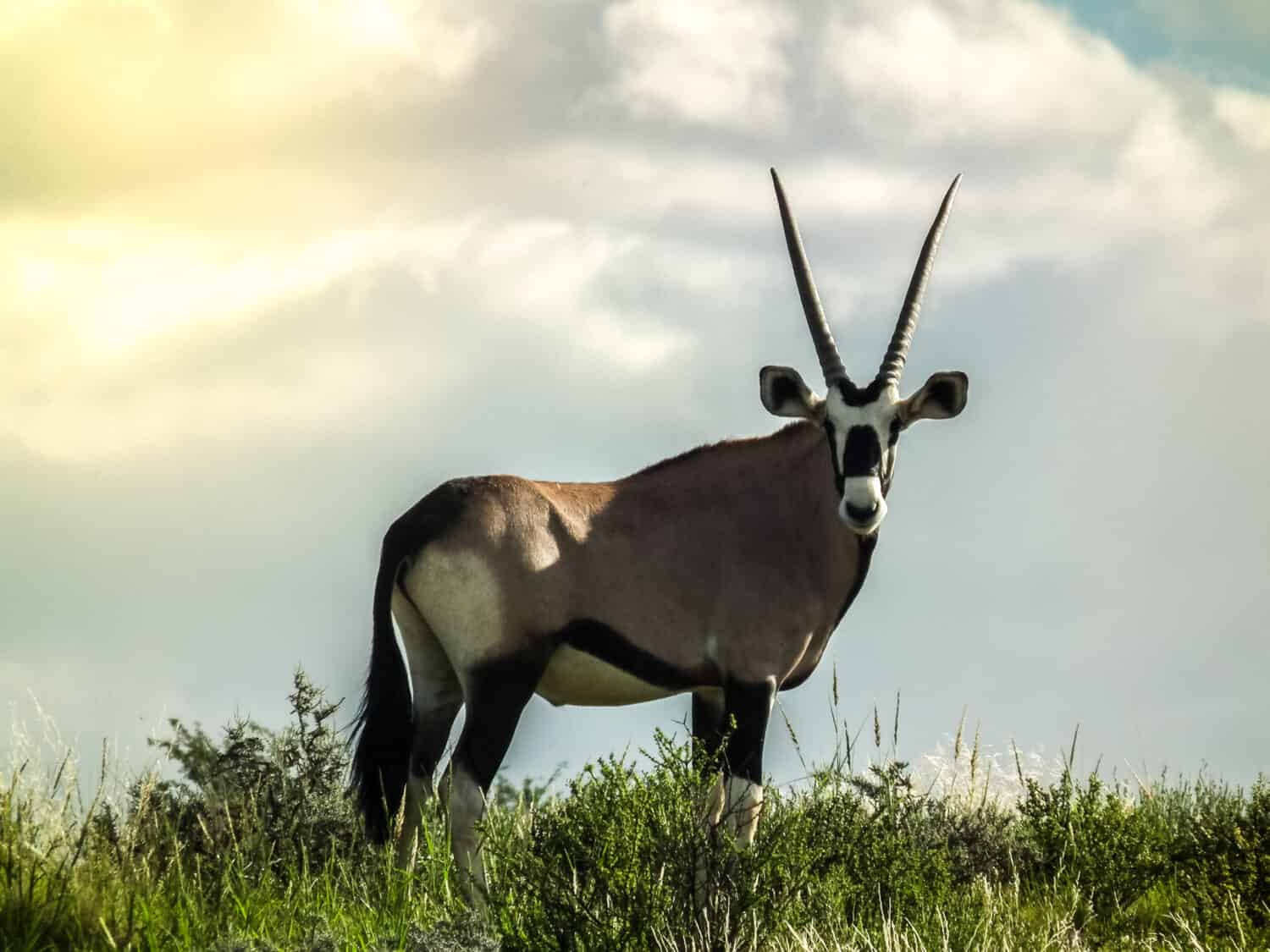
Gemsboks are the largest species in the
Oryxfamily.
©Gerhardus Kotze/Shutterstock.com
The gemsbok is, perhaps, one of the coolest animals in the United States. This exotic animal, also called the African oryx, is not native to North America. Instead, the New Mexico Department of Game and Fish introduced the species in the late 70s in an effort to increase big game hunting opportunities in the area. Now, the population rests in the thousands and poses a threat to the local ecosystem. This is, in part, because the gemsbok has no natural predators in New Mexico. Efforts to manage the species include erecting barriers and offering hunting permits. The Department of Game and Fish seeks to contain gemsboks in the 2.2 million-acre White Sands Missile Range and control the population.
There are a few areas for the public to view gemsboks. Sevilleta National Wildlife Refuge is home to many herds of these oryx. You can also spot them along Highway 70 between White Sands National Park and the San Augustin Pass.
Cool Fact: Gemsboks breed all year round, giving the species a distinct advantage for surviving and maintaining its population.
9. Ocelot (Leopardus pardalis)

The San Diego Zoo claims ocelots have one of the most beautiful coats in the world.
©Leonardo Mercon/Shutterstock.com
Big cats are popular on many wildlife enthusiast lists, and the ocelot is no exception. With a striking coat and a solitary nature, this stunning mammal is a must-see in the United States. It might be hard to spot them, though – ocelots are nocturnal and only inhabit a small portion of the country. Two small ocelot populations, numbering only 50-80 cats, inhabit an area in southern Texas, most living on private land. If you do spot an ocelot roaming wild in Texas, the Texas Parks and Wildlife Department requests that you report as much information as you can gather (time, location, date, size, habitat, behavior) to them as soon as possible.
The ocelot faces extinction in the United States due to habitat loss, so it is important to be extra respectful of its remaining territory. You can learn more about ocelots at the Laguna Atascosa National Wildlife Refuge in Los Fresnos, TX.
Cool Fact: Aztec and Incan civilizations incorporated ocelots into many of their stories, myths, and cultural arts. Salvador Dalí kept an ocelot, Babou, as a pet.
10. Moose (Alces alces)
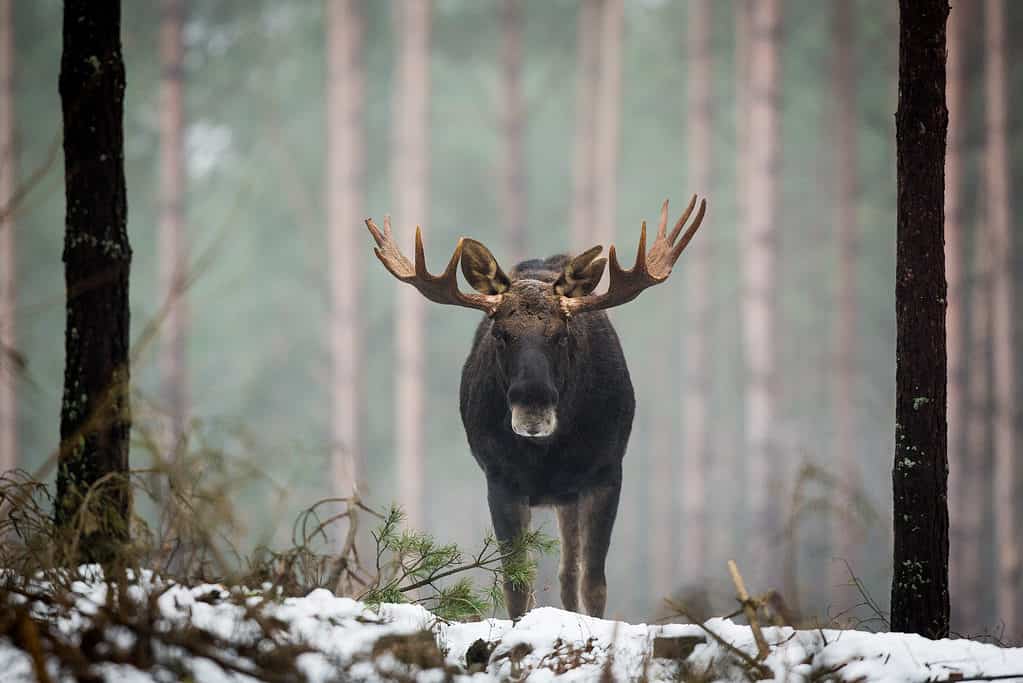
The largest moose ever caught in the world belonged to the Alaskan Yukon moose subspecies.
©Szczepan Klejbuk/Shutterstock.com
Moose are the largest of all deer species and an exciting animal to view from afar across many states. There are four subspecies of moose in North America, the western moose (A. alces andersoni), the Shiras moose (A. alces shirasi), the eastern moose (A. alces americana), and the Alaskan moose (A. alces gigas). Moose are a rare species, but you can sometimes be lucky enough to spot them in the wild. Moose live in northern states, such as Alaska, Washington, Idaho, Montana, North Dakota, Minnesota, and the upper peninsula of Michigan. There is a large population of moose in Maine, numbering over 76,000. Small numbers of moose also exist as far south as Utah, Wyoming, and Colorado.
Cool Fact: Moose dive for some of their food, and they are able to stay submerged for up to 50 seconds while feeding!
11. Coati (Nasua nasua)
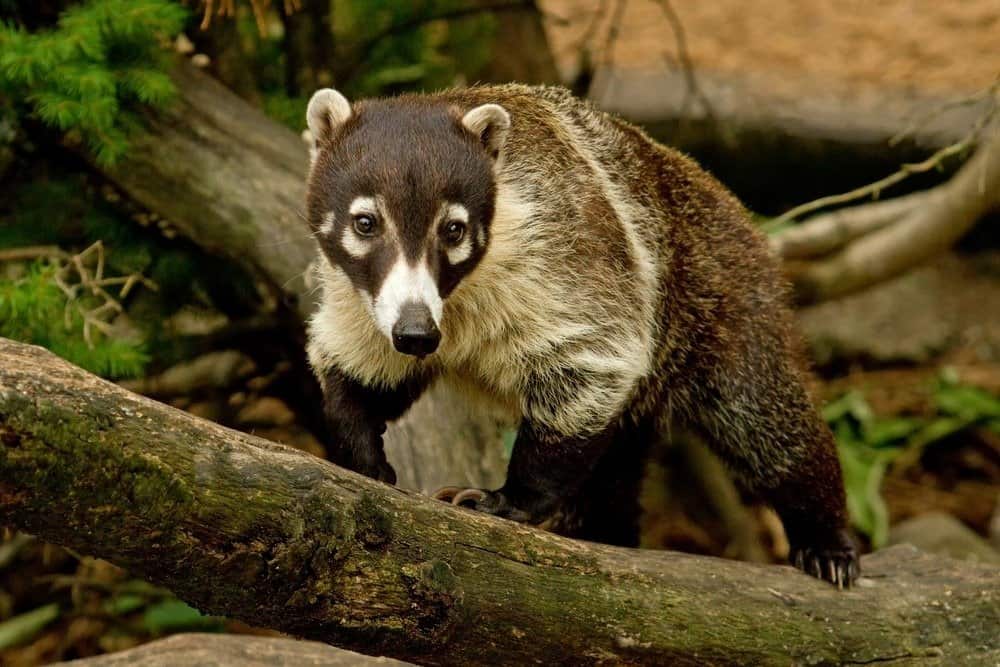
The coati is related to a much more familiar mammal – the raccoon.
©Cynthia Kidwell/Shutterstock.com
The coati is another incredible southwestern mammal, and it makes its home in Arizona, New Mexico, and Texas. Coatis around the world live in dense forests most frequently, but the coatis of the southwestern United States inhabit dry canyons, grasslands, and forests instead. Many people think ‘Coati’ is short for ‘Coatimundi’, but this is not true. The longer version of its name is actually a nickname, given to the male coatis for their solitary nature. Female coatis stay together with their young to form bands that reach up to 24 in size, but the adult male coati remains solitary until breeding season.
Cool Fact: The coati has reversible ankle joints, allowing it to scramble up and down trees in any direction, including headfirst.
12. Florida Manatee (Trichechus manatus latirostris)
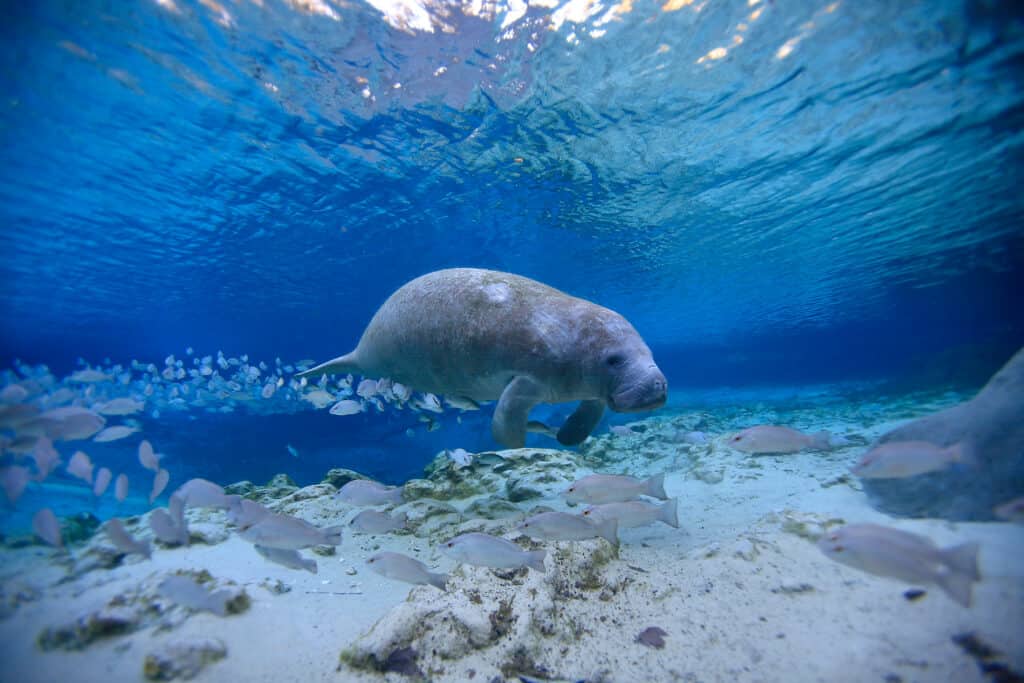
Manatees are mostly in Florida but have been found as far north as Rhode Island!
©Thierry Eidenweil/Shutterstock.com
Last on this list is the Florida manatee, a really special subspecies of the Indian manatee. This large herbivore grows to lengths of up to 13 feet and weighs between 1,000 and 3,500 pounds. There are over 8,000 manatees living in Florida, and there are a variety of places you can go to see them. The best time of year to see a manatee is during the winter when the herds – known as aggregations – migrate to warm inland waters. Crystal River in Florida is a popular destination if you want to catch a glimpse of these beloved sea cows – and even have a chance to swim with them! The Florida Fish and Wildlife Conservation Commission offers extensive information on manatees.
Cool Fact: Manatees live in fresh and salt water, but must return to freshwater semi-frequently in order to survive.
Summary of 12 Coolest Animals in the United States
We’ve listed only 12 of the coolest animals in the United States, and there is much to explore outside of what you learned here! Make sure to learn about animals in your area, from where to find them to the roles they play in your local environments. For more information on wildlife in each state, you can visit our US States Animal List. To learn about cool animals around the globe, check out this article about 10 of the coolest animals in the world.
| Animal | Cool Fact | Where to Spot | |
|---|---|---|---|
| 1 | Peninsular Bighorn Sheep | Horns up to 30 pounds | Southern California |
| 2 | Tarantula Hawk | One of the most painful stings in the world | New Mexico, Arizona, California |
| 3 | Elegant Trogon | Secondary nesters | New Mexico, Arizona |
| 4 | Grasshopper Mouse | Immune to scorpion venom | Western United States |
| 5 | Ghost-Faced Bat | Mysterious and elusive | Texas, Arizona, New Mexico |
| 6 | Brahminy Blind Snake | The smallest snake in the world | Florida, Connecticut, California, Georgia, Louisiana, Massachusetts, Hawaii, Arizona, and Texas |
| 7 | Humpback Whale | Migratory distances up to 5,000 miles | Alaska, Hawaii, California, Maine |
| 8 | Gemsbok | Year-round breeding capabilities | New Mexico |
| 9 | Ocelot | Salvador Dali kept an ocelot as a pet | Texas |
| 10 | Moose | Can feed underwater for up to 50 seconds. | Alaska, Washington, Idaho, Colorado, Wyoming, Michigan, Minnesota, Maine, North Dakota, Montana |
| 11 | Coati | Reversible ankle joints for enhanced climbing | Arizona, New Mexico, Texas |
| 12 | Florida Manatee | Lives in fresh and saltwater | Florida |
The photo featured at the top of this post is © Michael Liggett/Shutterstock.com
Thank you for reading! Have some feedback for us? Contact the AZ Animals editorial team.







